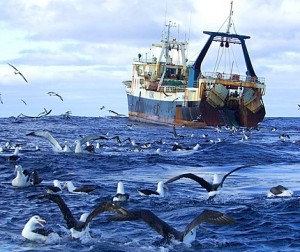 High seas bottom trawlers catch some of the tastiest fish (think Orange roughy, rockfish, and Patagonian toothfish), which are also some of the most vulnerable and overfished species because they grow and mature so slowly. A new study shows that this type of overfishing continues because the 200-strong trawling fleet is kept afloat with government money.
High seas bottom trawlers catch some of the tastiest fish (think Orange roughy, rockfish, and Patagonian toothfish), which are also some of the most vulnerable and overfished species because they grow and mature so slowly. A new study shows that this type of overfishing continues because the 200-strong trawling fleet is kept afloat with government money.
Several members of the Sea Around Us Project led by fisheries economist Rashid Sumaila estimated bottom trawl fleets operating in the high seas, i.e., outside of the Exclusive Economic Zones of maritime countries, receive an estimated US$152 million per year in fisheries subsides, which is 25% of the total landed value of the fish. The profit achieved by this vessel group is normally not more than 10% of landed value, which means that without subsidies, the bulk of the world’s bottom trawl fleet operating in the high seas will be operating at a loss, and unable to fish, thereby reducing the current threat to deep-sea and high seas fish stocks. The study is titled Subsidies to high seas bottom trawl fleets and the sustainability of deep-sea demersal fish stocks and was published online this month in the journal Marine Policy.

